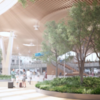A rendering of the future PDX ticket lobby. Courtesy of Port of Portland
To read more of Hannah Wallace's article, please click here.
When passengers pass through the newly remodeled Portland International Airport in spring 2024, they’ll be able to point up to specific Douglas fir beams around the oval skylights and know that they came from the ancestral lands of the Coquille Indian Tribe in Southwestern Oregon.
This will be the first major US airport to have a mass timber roof, and all the timber for the project came from sustainably managed forests that are located less than 300 miles away. The soaring, nine-acre ceiling — which will have lots of natural sunlight streaming in through the skylights and windows — will feel a bit like a forest. (The renovation will also include the addition of 70 or so living trees that will be growing in recessed and above-ground planters.)
The process of sourcing the wood took six years of planning, research, forest visits and many, many phone calls between the Port of Portland, Portland-based ZGF Architects, regional tribes, family-run forests, mill owners and brokers.
When ZGF principal Jacob Dunn joined the firm in 2017, his colleagues were already considering going with an all-wood roof. The Port of Portland, the public authority that oversees the airport and marine terminals in Portland, loved the idea. “The Port’s mandate was: We want it to be a mass timber roof. We’re the front door to the region, we really want to showcase this industry that is critical to managing and stewarding one of our region’s most precious natural resources,” recalls Dunn, who is ZGF’s sustainability lead for the PDX airport project.
“So it’s just a very vibrant, ecologically diverse forest. And that unlocks all the superpowers of a forest’s ability to clean air, clean water, provide habitat, provide carbon sequestration, fire resilience. It all comes down to diversity,” Dunn says.
What Dunn learned during that time boiled down to three main tenets for maintaining the diversity of natural forests: Make smaller harvests, cut down older trees and leave more trees behind.
The Skokomish tribe also went well beyond these tenets. When ZGF and the Port of Portland’s teams went out to the forest, they met with CEO Thomas Strong who showed them how the tribe does low-impact forest restoration. “They were looking at almost single tree removal and restoration, which was still producing a fair amount of wood that could go into something like the airport,” Dunn says. When he says “almost,” what Dunn means is that the tribe never cuts down two trees right next to each other. So even if they cut down, say 20 trees per acre, it still looks like a forest.



Comments (0)